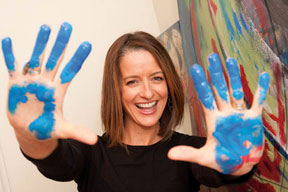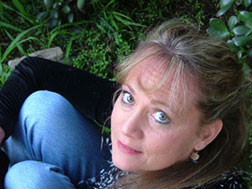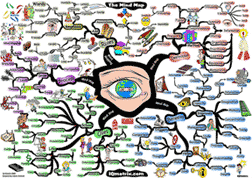reativity, an integral part of writing, is often elusive. What can a writer do to try to recapture or increase creativity and allow it to flow onto the page? There are a variety of exercises and tools to help a writer tap into her creativity, including brainstorming.
Exercising Your Creative Muscles
“Creativity is just as accessible as not,” says Whitney Ferré, author and creativity trainer. “Creativity is basic to the human species.”
Ferré believes all are born with creativity, just as they are born with a bicep. And, just as with our bodies’ muscles, Ferré encourages people to develop and exercise their creativity. She is the founder of The Creative Fitness Center in Nashville, Tennessee.
Ferré, who has published 33 Things to Know about Raising Creative Kids and The Artist Within: A Guide to Becoming Creatively Fit talks to WOW! about research that depicts the left-right brain hemispheres.
As writers, she says, often we are hit with a degree of what might be termed as writers’ block and are probably spending a lot of time in the left side of the brain, the less creative side. Ferré and others in the creativity field suggest creativity exercises to return to using more of the right side, which is seen as the more creative area of the brain.
Writers “understand that ideas aren’t flowing” and they need a vehicle to get into the right brain, says Ferré, who has found in her own writing that sometimes her left brain has taken over and stalled her writing. She felt a fear was triggered and she was stuck. Ferré found herself engaging in a creative activity, leaving behind her left brain, engaging with her right brain and being able to write in a stream of consciousness, which was “effortless.”
“We live in such a left-brain world,” Ferré tells WOW! in a telephone interview, as she lists technology, driving, and bills as some of the daily complications that keep us in the brain’s left hemisphere. Even when trying to negotiate the right side of the brain, days are often filled with left-brain activities and give our lives a more linear focus.

“If you are not feeling creative, you have been taken over by one thing.”
(Photo: Whitney Ferré)
“Our focus in our lifestyle has become linear: get the education, get the job, get the money,” says Ferré. “If you are not feeling creative, you have been taken over by one thing.” Maybe it’s your work, maybe it’s the extracurricular activities, or maybe it’s the kids. Bringing back proportion and balance can be one aspect of returning to one’s creativity.
Ferré cautions against too much left-brain focus. “The great writing or art comes from that intuitive side because there is some kind of breakthrough involved. You can't get that from the left side. Your left brain is the big file cabinet. New ideas have to come from the right brain perspective. That’s the only way it works.”
According to Ferré, shifting from left brain to right doesn’t have to be a long-term process. Ferré gears her creativity training toward exercising one’s creativity with the reminder that if you want to run a marathon, you wouldn’t just walk outside your door and start.
When writing has become the business, for example, Ferré recommends taking about 5 minutes to make the shift from left to right to re-engage the mind creatively.
“We can change things pretty quickly,” she says suggesting a shift by using a creative or a meditative activity.
During the interview, Ferré mentions the Creative Education Foundation (CEF) and its Creative Problem Solving Institute (CPSI), which teaches brainstorming.
In 1954, Alex Osborn created CEF and the term brainstorming. Ferré explains that there are many variations of the creative problem solving process. But most importantly, when taking the time to list ideas, themes or solutions, one must suspend opinions or judgments to keep the ideas coming.
“The Aha! idea will be the 35th or 36th idea of 40,” Ferré says.
Exciting Your Creative Muses
Jill Badonsky, the founder of Kaizen-Muse Creativity Coaching, sees brainstorming as just one of the many tools that can be used to help access one’s creativity.
“Brainstorming allows for a fluid stream of idea generation without judgment. Pressing our brains to come up with more than one answer or idea is a foundation for creative thinking,” Badonsky writes in an e-mail interview with WOW! “When we do this regularly, we actually create new brain pathways that make idea generation more accessible and fluid. Brainstorming over time can be compared to turning on a faucet of ideas when formerly there was just a drip. The more we brainstorm, the more ideas are accessible, the more choices, possibilities, combinations, associations, and extrapolations can be made. Brainstorming also invites the mind to play and ask questions. These are two actions that are vital to the creative process.”

“For writers, being resourceful through brainstorming means entering into the refreshingly welcomed spheres of complex characters, imaginative plots, and inventive description.”
(Photo: Jill Badonsky)
Badonsky, who penned The Awe-manac: A Daily Dose of Wonder and The Nine Modern Day Muses (and a Bodyguard): 10 Guides to Creative Inspiration, writes that brainstorming helps one tap into something beyond the usual.
“For writers, being resourceful through brainstorming means entering into the refreshingly welcomed spheres of complex characters, imaginative plots, and inventive description. Brainstorming forges past the predictable and into the delightful—where there are more choices, there is more brilliance and potential for creativity.”
After reading Po Bronson’s Newsweek articles “The Creativity Crisis” and “Forget Brainstorming” you might be discouraged and plan to pass on brainstorming as a way to improve your writing.
But, according to Badonsky and Ferré, when practiced in a compassionate and non-judgmental way, brainstorming can play a supportive role in your writing. While brainstorming often can occur in a group setting, it is also quite accessible to the solo creative spirit. CEF, in its rebuttal to the articles, advocates small groups and/or brainstorming by individuals.
“There are as many different types of brainstorming as there are creative minds. There are, however, formulas that companies seem to pull out for brainstorming meetings that include different steps and the smart brainstorm leader will intuitively know how to tweak those steps according to the organic direction the process is taking. There is nothing wrong with starting with someone else's guidelines,” Badonsky writes. “The creativity comes in modifying those guidelines to work for your intuition, individuality, rebelliousness, risk-taking, defiance, absurd notions, and other precursors to creative brilliance.”
Badonsky proposes, if brainstorming in a group, ensuring that the brainstorming gets a chance to take off, including not “cutting people off too soon, going too quickly into the evaluation phase, showing any kind of judgment toward any ideas that emerge will sabotage the possibility of excellence, fun, and freedom that brainstorming can invite.”
Opening the Idea Spigot
Besides engaging the services of a Kaizen-Muse Creativity Coach, Badonsky has a few tips to help with tapping into creativity through brainstorming.
Badonsky has given brainstorming, one of the 10 tools of the Kaizen-Muse Creativity Coaching, a tweak as she personifies it in her The Nine Modern Day Muses (and a Bodyguard) book. Badonsky’s Albert serves as a muse-guide to “brainstorming, listing and idea fluency.”
In an excerpt from her e-mail, Badonsky proposes that in attempting brainstorming:
- List often. Listing is a form of brainstorming. The more frequently you list ideas about characters, plots, words, emotions, approaches, associations, etc. the more you will develop your idea fluency muscle. After a while, you will automatically be more resourceful.
- Have an attitude you begin with before you start a list. Personifying an attitude of anger, expert, big, minimalist, confused, big shot, beginner, or maniac will elicit different lists of ideas than simply starting from your usual frame of reference that may be overdrawn or tired.
- Look into mind-mapping as a way to brainstorm in a non-linear fashion much the way our mind operates.
Badonsky recommends that within the different plans, find an activity that energizes you.
What Does Brainstorming Have to Do with a Refrigerator?
So, how do you brainstorm? Bear with me while I cart out my refrigerator to make a visual point and explain my thoughts on why I propose using brainstorming for your writing.
Okay, so it’s all happened to us at some point. Open the refrigerator and the mustard, wilted celery, and orange juice container stare back at you. Some may just look at the refrigerator remnants and see just enough to make a meal. Not a satisfying meal, but something. But for others, the lack of food signals that it’s time to fill the refrigerator, but what is it that you should fill it with?
Maybe you have plans for a dinner party and you would like to make your aunt’s famous meatballs. Or maybe you need to make a meal for you and your family. Maybe a friend is ill and has asked you to make her favorite Bundt cake.
Now, stretch your imagination to think of your refrigerator as a storage place of your writing ideas, and your meals as your creative writing projects (with the invited guests equal to your book’s characters). Because you are a writer, you need to keep some ideas tucked away. You might have a character for a piece of writing, but you sit down to write and nothing is showing up on the page. It’s like opening that refrigerator and not having any food with which to prepare an elaborate (and publishable) holiday meal.
Some sit down to write without conducting any prewriting and pull from their standard fare. Others might open a few books, do a bit of research, take some notes and develop a creative creation. Conducting some brainstorming along the way can help expand and fill a story with ideas.
To stock that refrigerator, you’re going to need to write down some ideas and get some ingredients together for your story.
Think of this as a part of your pre-writing stage.
Pre-Writing Can Exercise Your Creativity
When teaching writing, I’ve often found that many students don’t seem to throw enough focus on each of the different steps involved in writing: pre-writing, writing, and revising. Creativity can play a part in all three stages.
Certainly, if supported, the pre-writing stage can help a writer gain access to a variety of ideas that might not have appeared without taking the time. What happens when you approach your writing with a variety of questions or just space and time to grow your ideas? Often you get surprising answers that expand your choices even more. You’ve moved beyond the tip of the iceberg because your few ideas help to generate more ideas; your creative right side is engaged.
A brainstorming session is born.

“The less judgment introduced into brainstorming, the more free flowing the ideas can become.”
Why Brainstorming (Maybe) Didn’t Work in the Past
Brainstorming or mind-mapping might be something you have used in the past. If you have worked in an office, brainstorming may even be a familiar drill: Sit around with your colleagues and sound out ideas, which someone writes on a big piece of paper or whiteboard.
Sometimes brainstorming with colleagues doesn’t seem totally fulfilling. Frequently, we don’t give enough time or distance between brainstorming and culling our list for suitable working ideas. Sometimes we pre-filter our own responses during brainstorming, stifling our answers because we judge them as “too silly.”
One of the reasons brainstorming can be effective is that a person needs to stifle the inner critic that says “too silly,” instead of stifling the idea. The less judgment introduced into brainstorming, the more free flowing the ideas can become.
Putting the Practice in Brainstorming
As you know, as a writer, facing a blank page can be intimidating. Maybe you have a story idea, but you’ve run into a problem in the narrative? Unlocking being stuck can often start with a brainstorming session.
Find a story you are working on, or one you’ve stuffed into the desk drawer to work on later. Then use this space to brainstorm about it.
Don’t have anything handy? Then perhaps you might want to write a short story about John, a naturalist who has launched a program to save sea turtles at the same time he is fighting a bitter custody battle for his 9-year-old son.
Some writers might just jump onto the page and start writing. For others, they want to start seeing a shadow of who John is. What are five important things about John?
Let’s try one approach to tap into John and his life (or to work on your story’s narrative).
Take some time right now and pull out a piece of paper and jot down the first five questions, ideas or descriptions that come to your mind:
-
-
-
-
-
Generally, getting back to the refrigerator, you might consider these the accompaniments to the mustard, wilted celery, and orange juice in the refrigerator.
Now, try to get to 25 questions. Don’t stop, don’t edit and don’t judge as you write. Just get the ideas of what you want to ask on the page.
-
-
-
-
-
-
-
-
-
-
-
-
-
-
-
-
-
-
-
-
Great job! Is your inner critic still out to lunch? Super. Can you keep going? If so, do so.
At the end, did you find some surprising elements to John? Did it become easier or harder as you went along your list?
TIP: To truly experience brainstorming, don’t stop yourself when you start your list. Keep writing your list without judgment or editing. Just keep those ideas coming about our naturalist John.
With this brainstorming exercise, you are filling your refrigerator with a few other items that will help build a magnificent meal. Later, you might sift through the ideas a little before starting to write. Or not.
Generating these ideas has helped to set the baseline for John. Nothing is written in stone, but you have the sketches of a character.

“Mind-mapping can work as way to start with the kernel of an idea and keep expanding it.”
(Photo by zipckr)
Mapping Your Mind and Creativity
Mind-mapping is another tool in accessing creativity and problem solving. Instead of making a list, mind-mappers draw diagrams.
Mind-mapping is useful alone or combined with brainstorming or another technique. Mind-mapping can work as way to start with the kernel of an idea and keep expanding it. Pull out the pens, pencil, colored markers—or whatever you have on hand—to either draw your own mind map or use some of the free templates available on the Internet.
For example, take the same story (yours or John, the naturalist) and massage it using mind-mapping, which can also help increase your creativity. Some creativity experts suggest that mind-mapping actually enables both sides of the brain simultaneously.
While there are various methods and guidelines for mind-mapping, as with brainstorming, unleashing one’s creativity comes from releasing the confines of judgment. Similarly to brainstorming, the one guideline is to do what you can to let the words and ideas flow.
Now, think about your own character or our naturalist again:
- Place John’s name in the center of page.
- Draw a line out from the circle and write his child’s name and then draw one out about another person in his life. (Or focus on events of John’s life or his characteristics or, well, anything you’d like.)
- Radiate more lines as you allow your creativity to take over and throw you ideas about John. Alternate the colors you use for the radiating lines, if you feel like it. (Some even recommend using a mind-map for taking notes during lectures.)
- Keep going!
It’s All in the List
Enjoy jumping into the brainstorming or mind-mapping and let your creativity flow. Keep in mind that a creativity coach, trained in understanding the non-linear pathway of creativity, can help support creative flow and provide other tools, suggestions or exercises to re-invigorate your creativity and enliven your writing.
***

Author Bio:
Elizabeth King Humphrey, a certified Kaizen-Muse Creativity Coach, is a writer, editor, coach and reviewer who earned her MFA at the University of North Carolina Wilmington.
To find out more, visit: www.thewriteelizabeth.com.
-----
Related article on WOW!:
Making Time for Left- and Right-Brain Writing by Cathy C. Hall